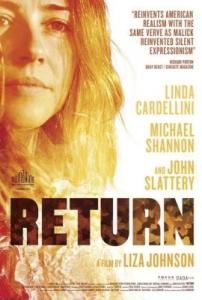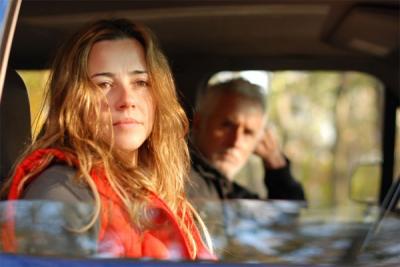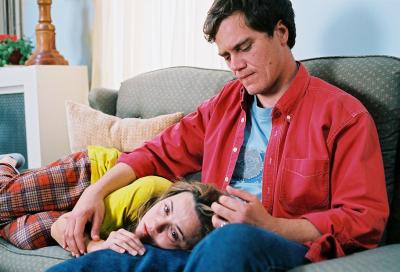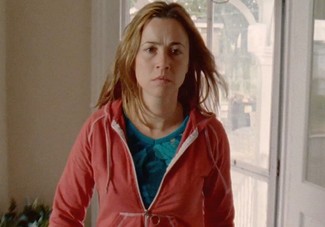By: debbie lynn elias

The women finally get their day with Liza Johnson’s RETURN, the moving character study of Kelli, a wife, mother and soldier who is more than anxious to return to her small town life in the Rust Belt of the United States and resume the longed for routine of fixing family dinners, talking about her daughters’ day at school, playing dress up with her girls, and returning to her job as a factory worker. On the film’s opening frame, we see Kelli, the perfectly groomed soldier, deplaning and searching the airport crowd with nervous anticipation for her family. Her excitement is palpable as our hearts beat faster along with hers only to hit a brick wall as Kelli’s reunion is anything but joyous. Life has changed while she’s been gone. Her husband has changed. Her daughters are strangers to her. And in a flash, both Kelli and us, know that her life will never be what it was.
Pounced on by friends and family at an impromptu coming home celebration, folks are taken aback when Kelli cracks open a beer, and is anything but the quiet homemaker everyone once knew. Gossip abounds of local doings but Kelli is left out in the cold with the conversation as she hasn’t been around and no one wants to bring her up to speed. Her kitchen is rearranged. Glasses are on a top shelf, more accommodating to the height of her towering husband and female friends he has made in a spousal support group. Towels are in a new cabinet. And it looks like dinners are more “to go” rather than home cooked. At night, Kelli finds solace sleeping on the hard floor of her daughters’ bedroom rather than curling up with her husband. As her husband’s plumbing business is hit and miss, the family needs money, forcing Kelli to immediately return to work at the factory job she left behind.
Feeling lost and alone, no matter how hard she tries, Kelli just can’t seem to acclimate to her returning life and continues to feel like, and be treated like, a stranger. With pressure mounting, Kelli snaps. She quits her job and lays on the couch day after day. She starts to paint the living room walls to “make it brighter” but after a few swipes of the paint roller, stops. Alcohol becomes her friend. And she discovers that her husband has been having an affair with another woman, an affair that he has no intention of ending now even though Kelli is home. At the end of her rope, Kelli gets tagged with a DUI, her former job is now completely gone as the factory has closed, and she gets new orders – she’s returning to Iraq.

Linda Cardellini shines as Kelli. Using strong emotional brushstrokes, she paints Kelli with texture, depth and honesty. Her face is expressive and her mannerisms telling, adding much to the ambient characterization of life. According to Cardellini, on reading the script she was most impressed by writer/director Liza Johnson’s “unique vision for the film. It wasn’t anything I had heard about in any kind of returning soldier story. It was very much focused on the details and the silences and the little things that unravel in this woman’s life after coming home from something that we all hear about but maybe don’t necessarily known enough about. . .We live our normal lives and they’re over there sacrificing a lot for us while we go about our daily lives here. I wanted to know more about that. I wanted to pay respect to that. ” Describing the role as “restrained”, Cardellini was impressed on the way that “Liza orchestrated the performances – they don’t spell everything out for you. It leaves you some room to decide what you think for yourself. And I like the idea that [Kelli] doesn’t have a way of communicating perfectly. . . I hoped it was a very realistic way of looking at somebody returning in a way that was different from what people had seen before.”
To prepare for the role, Cardellini talked to returning soldiers, both male and female. “I tried to speak with as many [soldiers] as I could. Some were happily being redeployed, staying in the military. Another woman I spoke to was in the VA Hospital trying to get treatment for PTSD and was very young. . . Some people, some men as well, just so I could understand a more generalized version of [returning home] and also a more genderized version of it. I think there are common threads throughout everybody’s story but everybody’s story was also very different. What was interesting to me [is that] there’s so much that people go through [and yet] some people have one specific trauma and other people don’t have a specific trauma to point to, but the idea of being there – whether it’s the sadness or the anger or the disruption to their normal life – changes them.”

Distressing with casting is Michael Shannon as Kelli’s husband, Mike. At no time do we see any chemistry that would lead one to believe Kelli and Mike could ever have been a couple. On the flip side, Cardellini and John Slattery are magic together. As Bud, a fellow vet whom Kelli meets at her court ordered halfway house rehab program, Slattery brings out the best in Cardellini’s Kelli with both characters being strong, confident, self-sufficient. There is an immediate visible connection between Cardellini and Slattery when their characters meet. As one sees and feels the disconnect between Cardellini and Shannon, the opposite occurs with Cardellini and Slattery. As described by Cardellini, with the appearance of Bud, “Kelli gets a break from all of the heaviness and thinks that she’s found somebody who really understands her, which I think is why it’s so heartbreaking when she walks in and he’s grinding up those pills. But, it was really fun to have fun on set with John in those scenes because you got a glimpse of the Kelli that may have existed when her life wasn’t so heavy.” Bud is a turning point in the film and Slattery plays it beautifully. With the appearance of Bud, you feel Kelli’s comfort at finding a kindred spirit almost as if a big Band-Aid has been applied to her heart and life. Here is a man meeting the world on his own terms. But then the Band-Aid comes unstuck in the morning when Kelli sees Bud’s true personality, leading to a significant and powerful scene with Kelli walking home, under her own power, on her own two feet, showcasing yet another metaphoric aspect of putting one foot in front of the other to get through each day…much as Kelli did while in Iraq. A very powerful second act in the film.

And be on the lookout for the most authentic sex scene I have ever seen on the screen which is beautifully and realistically played between the two
Written and directed by Liza Johnson, RETURN is chock full of beautiful metaphoric symbolism for the mental and emotional state of Kelli on her return from the war. Importantly Johnson shies away from the perceived definition of PTSD and as opined by Cardellini, speaks to ” the idea of being there – whether it’s the sadness or the anger or the disruption to their normal life” and how it changes a person. Open and obvious metaphors start with the paint in the house. Seeing that things aren’t the same with her marriage, her kids, work, her town, life, the paint is Kelli’s metaphoric attempt to “paint over” the surface of the problems which, as we see from the unfinished, splattered walls, looks more like piling bandages on top of different wounds that are too big to fit under the gauze. And of course, where was Kelli’s primary duty in Iraq? Through the dialogue we learn, the hospital and hospital supply (and how ironic that of all actresses, Cardellini, best known as Nurse Samantha Taggert in “ER”, is now cast as Kelli?). Also telling are quick lines of dialogue about an entire warehouse of disposable gloves, i.e., wear them to keep the dirt of war and illness from touching you and then discarding them, slipping on a new pair with each new mess. And how about Kelli’s broken car window? Cover it up with plastic and duct tape. Alcohol also serves as a means to hide the problems Kelli returns to.

Dialogue has a fluidity and cadence that is welcoming and believable. Lensing makes great use of close-ups, a style which suits this story perfectly by not only adding to the personalization, but the intensity and confusion of the world Kelli is facing. Wide shots are used judiciously and show the audience us what Kelli doesn’t realize or accept about herself. As she walks and walks under her own power, striding with arms swinging, putting one foot in front of the other, moving onward and forward, we see unspoken strength and fortitude. Beautiful. In a significant scene between Kelli and Bud, there is great clarity that comes with the serenity of a crystal lake and the life’s blood of the colors of fall foliage. Mid and wide shots in the factory setting show us a Kelli who is confident, knows what’s she doing and doing it. Get the job done. All of the decisive elements of the character are showcased with the mid and wide lensing. Very effectively done.
Without bogging down the dialogue in economic discussions and how the country has changed for so many coming back from the war, Johnson lets the camera do the talking as it repeatedly takes us on drives through the town showing business after business boarded up. There are only one or two sentences from Mike about the family needing Kelli to work because they need the money. And we are tacitly led to believe that the day after Kelli returns, she goes back to the factory to work. Johnson intelligently realizes that much of her audience is already in an economic pickle and they don’t need to be force fed the obvious.
SPOILER ALERT: The film is smartly book-ended with Kelli’s arrival and departure. And again the camera speaks louder than any words. The look on Kelli’s face on returning home in is not one of real joy, but rather one of confusion. There is no connective tissue between Kelli and Mike and, in fact the chemistry between Cardellini and Shannon is so non-existent, they come across as two strangers uncomfortably meeting for the first time. On Kelli’s second sitting in the airport alone, she looks relaxed, confident, sitting tall, knowing her place and who she is when she’s in that uniform. We leave her alone but in an emotionally secure place; she knows who she is as a soldier and she knows that life will never be the same as it was before she went to war; that she isn’t the same person she was before the war.

A shortcoming is with the film’s time table which is all over the place, never giving us a real sense of the passage of time. Kelli gets drunk, drives, gets picked up by a cop, but contrary to the film’s dialogue, she would not immediately lose her driving privileges just on her way home. One daughter is cheerleading which would make one think football, yet Christmas decorations were being taken down. Another dresses up like a Mummy. Is it Halloween? Clothing and the seasons also don’t reflect any change, giving us a sense of events happening on a sequentially daily basis which proves disconcerting, detracting from the film and the character study. Pacing is at times uneven, adding to the confusion with the passage of time. And there are some scenes that “drag” rather than “linger.”
So significant – and I cannot stress this enough – is the fact that Johnson tells this story from the female POV. This is the first American war where women, outside of MASH units, were actually at the battle fronts and directly in harm’s way. No one has done any film or tv movie addressing the female soldier’s return and I find this the most interesting and celebratory aspect of RETURN. We see a mother’s quandary, a woman’s quandary, a woman that’s been cheated on on the home front, a mother that wants to be with her children and the desperate lengths she will go to in an irrational state to try and be with them. Marriage becomes secondary to a mother’s love. But then it is the woman’s own needs and strength that rise up and ultimately make her the kind of woman her children will want to be with and be like.
Kelli – Linda Cardellini
Mike – Michael Shannon
Bud – John Slattery
Julie – Talia Balsam
Written and Directed by Liza Johnson.












